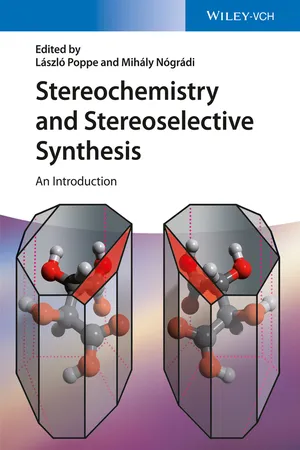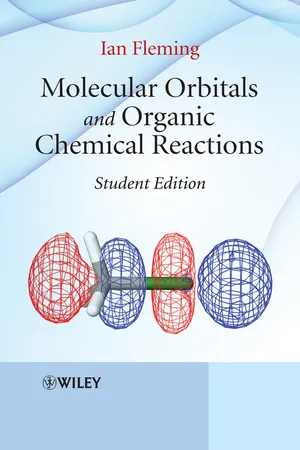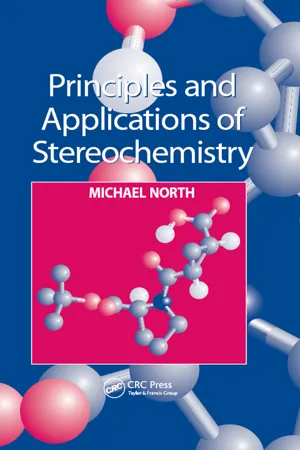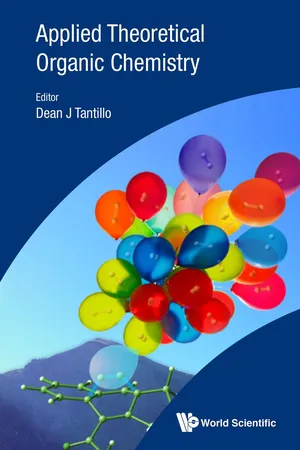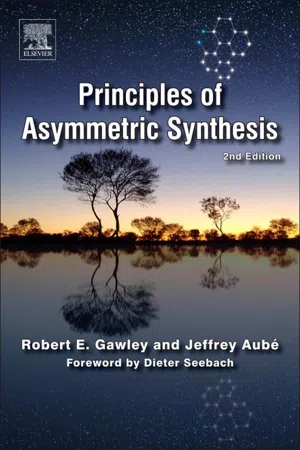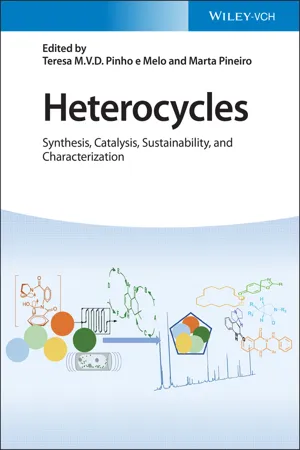Chemistry
Stereoselectivity
Stereoselectivity refers to the phenomenon in chemical reactions where a particular stereoisomer is formed in preference to others. This selectivity is often influenced by the spatial arrangement of atoms or groups within the reacting molecules. It plays a crucial role in the synthesis of complex organic molecules and pharmaceuticals, as well as in understanding the mechanisms of chemical reactions.
Written by Perlego with AI-assistance
Related key terms
Related key terms
1 of 4
Related key terms
1 of 3
6 Key excerpts on "Stereoselectivity"
- eBook - ePub
Stereochemistry and Stereoselective Synthesis
An Introduction
- Mihály Nógrádi, László Poppe, József Nagy, Gábor Hornyánszky, Zoltán Boros(Authors)
- 2016(Publication Date)
- Wiley-VCH(Publisher)
Part III General Characteristics of Stereoselective ReactionsSelectivity is an all-important key feature of chemical reactions. Selectivity enables multistep reactions to take place economically. Moreover, without selectivity it would be impractical to analyze and purify the products of reactions. After defining stereospecificity and Stereoselectivity, this part provides the reader with a systematic analysis of the various types of selectivties with special emphasis on selectivities leading to single enantiomeric products.Passage contains an image
Chapter 7 Types and Classification of Selectivities
Selectivity in chemistry is interpreted in various ways. The terms chemoselectivity, regioselectivity, and Stereoselectivity (including dia- and enantioselectivity) are widely used. However, there is no general agreement on their precise meaning. Therefore, the following chapters are dedicated to this topic and attempt to provide a uniform interpretative framework.7.1 Main Types of Selectivity
In chemistry, two main types of selectivities can be defined; one depends mainly on the properties of the substrate, while the other differs in the products of a reaction [1]. These two main types of selectivities are shown in the following figures.7.1.1 Substrate Selectivity
A reagent or a catalyst is substrate selective (Figure 7.1 ) when it transforms different substrates (S1 , S2 , …) to products (P1 , P2 , …) under identical conditions at different rates (k1 ≠ k2 ).Substrate-selective reactions.Figure 7.17.1.2 Product Selectivity
A reagent or catalyst is product selective (Figure 7.2 ) when it permits the formation of more than one product at different rates (k1 ≠ k2 ) from a single substrate (S) whereby the products (P1 , P2 , …) are formed in a ratio differing from the one statistically expected.1 - Ian Fleming(Author)
- 2011(Publication Date)
- Wiley(Publisher)
5 Ionic Reactions—StereochemistryTo achieve control of stereochemistry, understanding is vital, and understanding requires a feeling for all the factors that influence the stereochemistry of organic reactions. We begin with two adjectives, stereoselective and stereospecific, which, with their derived adverbs, are much used and misused. They are defined following Zimmerman below, and used carefully in this book, because the distinction between them is useful.The more encompassing term stereoselective simply means that more of one stereoisomer is produced than of one or more others. Thus the reduction of camphor 5.1 takes place mainly with attack of the hydride reagent on the lesshindered face, avoiding the C-8 methyl group, to give more isoborneol 5.2 than borneol 5.3. The degree of Stereoselectivity is expressed as the diastereoisomer ratio of isoborneol to borneol. It is helpful to normalise the numbers as percentages (90:10 in this case), without implying that the yield is 100%.The less simple term stereospecific is used for those reactions where the configuration of the starting material and the configuration of the product are related in a mechanistically constrained way. Thus the diastereoisomeric bromides 5.4 and 5.6 give different alkenes 5.5 and 5.7 by anti elimination. Since each of these reactions produces more of one isomer than the other, they are also stereoselective. The characteristic feature of a stereospecific reaction is that one stereoisomer of the starting material gives one stereoisomer of the product, and a different stereoisomer of the starting material gives a different stereoisomer of the product.This particular reaction was studied when analytical methods were not available to measure the probably small degree to which each isomer gave some of the other alkene, either by a different mechanism or by incomplete stereospecificity in the E2 reaction itself. No matter how much stereochemical leakage there is, as long as the diastereoisomer ratio is greater than 50:50, the reaction is still stereospecific. It is not helpful to use the word stereospecific to mean 100% stereoselective, as many people thoughtlessly do—a useful distinction is lost, and understanding suffers.- eBook - ePub
- Michael North(Author)
- 2017(Publication Date)
- Routledge(Publisher)
9 Stereochemistry of chemical reactions 9.1 Introduction So far in this book we have mostly discussed the stereochemistry of individual compounds. Chemistry is, however, concerned with the reactions of chemicals and the stereochemistry of the starting materials or intermediates is often important in determining the outcome of a chemical reaction. Hence, the last two chapters of this book will deal with the stereochemistry of chemical reactions. In this chapter, the stereochemical consequences of reactions which take place at or near an existing stereocentre will be discussed, as will reactions which generate racemic products by addition reactions to alkenes. Chapter 10 will then show how non-racemic chiral products can be obtained from achiral starting materials. It should be stressed, however, that reaction stereochemistry is an enormous area and these two chapters can only highlight the most important reactions. It is not possible to survey the stereochemical consequences of every possible reaction, nor is it desirable to do so; rather the reader should appreciate the underlying principles behind the stereochemical consequences of the reactions that are illustrated and be able to apply these to other reactions. The emphasis in these two chapters is on the reactions of organic compounds since these have been the most extensively studied and are the best understood. Before starting a survey of stereochemistry of chemical reactions, two new terms need to be defined. A stereoselective reaction is one in which only one of a set of stereoisomers is formed exclusively or predominantly. In a stereospecific reaction, one stereoisomer of the starting material produces one stereo-isomer of the product whilst another stereoisomer of the starting material gives a different stereoisomer of the product. It follows from these definitions that all stereospecific reactions are also stereoselective, but not all stereoselective reactions are stereospecific - eBook - ePub
- Dean J Tantillo(Author)
- 2018(Publication Date)
- WSPC (EUROPE)(Publisher)
Chapter 19
Challenges in Predicting Stereoselectivity
Elizabeth H. KrenskeSchool of Chemistry and Molecular Biosciences The University of Queensland, Australia19.1Introduction
Quantum chemistry has been responsible for many important discoveries in the fields of stereochemistry and asymmetric synthesis. Computational modeling of stereoselective reactions taps into the ability of quantum mechanical (QM) methods to characterize species that are not directly observable by experiment, such as transition states (TSs) and short-lived intermediates. Such calculations allow one to understand why a reaction favors a certain stereoisomer over another — and to what degree.This chapter will describe some of the conceptual and technical challenges encountered in the quantitative modeling of Stereoselectivity. The examples discussed will follow the development of the field over its 40-year history, highlighting several major milestones. Emphasis will be given to studies where computations have been used not only to rationalize the stereochemical outcomes of reactions but also to discover new chemistry ahead of experiment.There are several types of computational approaches for predicting Stereoselectivity. Most of this chapter will focus on the approach that utilizes quantum chemical exploration of reaction mechanisms, in particular transition-state modeling. Several alternative approaches, which utilize statistical analyses of structure–selectivity relationships or molecular mechanics modeling of TS structures, will also be briefly discussed.19.2Principles governing quantum chemical predictions of Stereoselectivity
The major stereoisomeric product of a stereoselective reaction that is under kinetic control, and the level of Stereoselectivity, can be predicted by comparing the computed activation barriers and energetics of the pathways leading to different stereoisomers. The simplest type of stereoselective reaction to model is one that gives two stereoisomeric products, (e.g., A → X + Y, where X and Y are diastereomers) and occurs in a single step under ordinary kinetic control (Fig. 19.1(a) ). According to TS theory, the ratio of stereoisomeric products X:Y is determined by the difference between the Gibbs free energies of the TS structures TSX and TSY (Δ ). In terms of the activation barriers ( - eBook - ePub
- Robert E. Gawley, Jeffrey Aube(Authors)
- 2012(Publication Date)
- Elsevier(Publisher)
Science of Synthesis, Houben-Weyl Methods of Molecular Transformations , is being published in both paper and searchable electronic formats.It is our primary aim to provide a concise analysis of the stereochemical features of transition states in a variety of reaction types. These features are a manifestation of the intra- and intermolecular forces that govern transition state assemblies, which can sometimes be modeled by computers. The ultimate (attainable?) goal of stereoselective synthesis is clear: the production of any relative and absolute configuration of one or more stereogenic units through the use of chiral catalysts that do not require consideration of chirality elements extant in the substrate.1.3 Stereoselectivity, and What It Takes to Achieve It
It is the primary goal of this book to analyze the factors that influence Stereoselectivity when one stereoisomer predominates over others. For illustrative purposes, consider the metal-mediated addition of a nucleophile to an aldehyde. The faces of aldehydes are heterotopic, either enantiotopic (if there are no stereogenic elements elsewhere in the molecule) or diastereotopic (if there are), as shown in Figure 1.1 . In order to achieve a predominance of one stereoisomer (enantiomer or diastereomer) over the other, the transition states resulting from addition of a fourth ligand to the heterotopic Re or Si faces must be diastereomeric. This will be the case if either the carbonyl compound, the reagent, or a metal catalyst (MLn ) are chiral. More than one stereogenic element, as in R* and ML* n gives rise to the possibility of matched or mismatched double asymmetric induction. In this chapter, we outline the physical principles that control selectivity, and provide precise definitions of stereochemical terms in the Glossary (Section 1.11 - eBook - ePub
Heterocycles
Synthesis, Catalysis, Sustainability, and Characterization
- Teresa M. V. D. Pinho e Melo, Marta Pineiro, Teresa M. V. D. Pinho e Melo, Marta Pineiro(Authors)
- 2022(Publication Date)
- Wiley-VCH(Publisher)
The photon is considered as a traceless reagent [ 6, 7 ]. For these reasons, these reactions are now highly appreciated in chemical and pharmaceutical industry [ 8 – 10 ]. Stereoselectivity also plays a central role in organic synthesis. Biological activity and material properties strongly depend on the stereochemistry of chemical compounds. Sooner or later, almost all synthesis methods will face this problem. In the past, photochemical reactions have been considered as being inherently stereo-unselective. It was thought that the high energy uptake by light absorption induces uncontrolled relaxation processes that lead to unselective reactions with large amounts of degradation either of the substrates or the photoproducts [11]. In this regard, it must however be pointed out that stereoselective and stereospecific photochemical reactions have been known from the very beginning of this research area [ 12, 13 ]. The controlled dissipation of the high electronic excitation energy in photochemical reactions is the reason for the high Stereoselectivity in such reactions [11]. In particular, photochemical reactions can be conducted enantioselectively in chiral supramolecular structures [ 14, 15 ]. Enantiopure compounds are obtained in different ways: they can be prepared directly from other chiral precursors such as natural products (“chiral pool”) or by optical resolution using different types of chromatography or crystallization techniques. Asymmetric syntheses using chiral auxiliaries, which are removed after the stereoselective reaction, also provide enantiopure compounds. Asymmetric catalysis and enzymatic catalysis directly yield enantioenriched compounds. A chiral enantiopure environment in a supramolecular structure or in a crystal may be the inductor of chirality in asymmetric reactions
Index pages curate the most relevant extracts from our library of academic textbooks. They’ve been created using an in-house natural language model (NLM), each adding context and meaning to key research topics.
Explore more topic indexes
Explore more topic indexes
1 of 6
Explore more topic indexes
1 of 4
